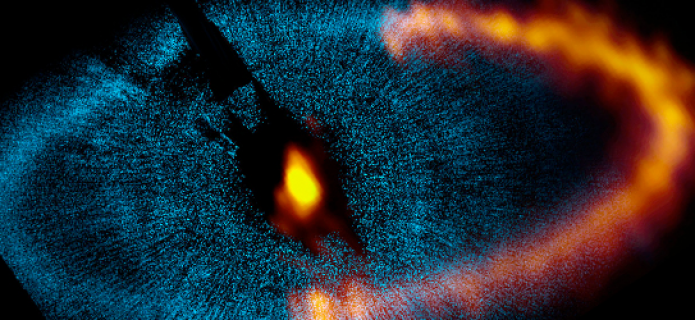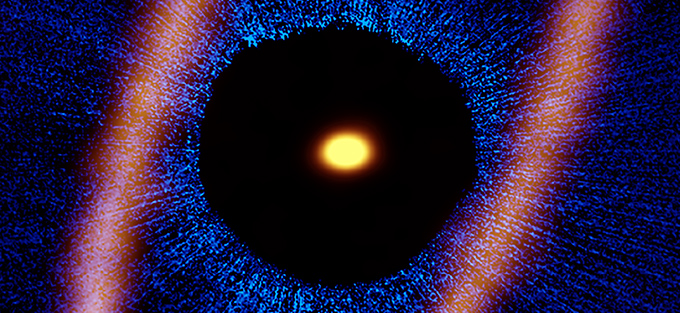ALMA Reveals Workings of Nearby Planetary System
A new observatory still under construction has given astronomers a major breakthrough in understanding a nearby planetary system and provided valuable clues about how such systems form and evolve. Scientists using the Atacama Large Millimeter/submillimeter Array (ALMA) have discovered that planets orbiting the star Fomalhaut must be much smaller than originally thought. This is the first published science result from ALMA in its first period of open observations for astronomers worldwide.
The discovery, which helped resolve a controversy among earlier observers of the system, was made possible by exceptionally sharp images of a disk, or ring, of dust orbiting the star, about 25 light-years from Earth. The ALMA images show that both the inner and outer edges of the thin, dusty disk have very sharp edges. That fact, combined with computer simulations, led the scientists to conclude that the dust particles in the disk are kept within the disk by the gravitational effect of two planets -- one closer to the star than the disk and one more distant. (1)
Their calculations also indicated the probable size of the planets -- larger than Mars but no larger than a few times the size of the Earth. This is much smaller than astronomers had previously thought. In 2008, a NASA/ESA Hubble Space Telescope image had revealed the inner planet, then thought to be larger than Saturn, the second-largest planet in our Solar System. However, later observations with infrared telescopes failed to detect the planet.
That failure led some astronomers to doubt the existence of the planet in the Hubble image. Also, the Hubble visible-light image detected very small dust grains that are pushed outward by the star's radiation, thus blurring the structure of the dusty disk. The ALMA observations, at wavelengths longer than those of visible light, traced larger dust grains -- about 1 millimeter in diameter -- that are not moved by the star's radiation. This clearly revealed the disk's sharp edges and ring like structure, which indicate the gravitational effect of the two planets.
“Combining ALMA observations of the ring's shape with computer models, we can place very tight limits on the mass and orbit of any planet near the ring,” said Aaron Boley, a Sagan Fellow at the University of Florida, leader of the study. “The masses of these planets must be small; otherwise the planets would destroy the ring,” he added. The small sizes of the planets explain why the earlier infrared observations failed to detect them, the scientists said.
The ALMA research shows that the ring's width is about 16 times the distance from the Sun to the Earth, and is only one-seventh as thick as it is wide. “The ring is even more narrow and thinner than previously thought,” said Matthew Payne, also of the University of Florida.
The ring is about 140 times the Sun-Earth distance from the star. In our own Solar System, Pluto is about 40 times more distant from the Sun than the Earth. “Because of the small size of the planets near this ring and their large distance from their host star, they are among the coldest planets yet found orbiting a normal star,” added Aaron Boley.
The scientists observed the Fomalhaut system in September and October of 2011, when only about a quarter of ALMA's planned 66 antennas were available. When construction is completed next year, the full system will be much more capable. Even in this Early Science phase, though, ALMA was powerful enough to reveal the telltale structure that had eluded earlier millimeter-wave observers.
“ALMA may still be under construction, but it already has proven to be the world's most powerful telescope for observing the Universe at millimeter and submillimeter wavelengths,” said Stuartt Corder, of the National Radio Astronomy Observatory, a member of the observing team. “This is just the beginning of an exciting new era in the study of disks and planet formation around other stars,” concluded Bill Dent, another observing team member, of the ALMA observatory.
The Atacama Large Millimeter/submillimeter Array (ALMA), an international astronomy facility, is a partnership of the European Organisation for Astronomical Research in the Southern Hemisphere (ESO), the U.S. National Science Foundation (NSF) and the National Institutes of Natural Sciences (NINS) of Japan in cooperation with the Republic of Chile. ALMA is funded by ESO on behalf of its Member States, by NSF in cooperation with the National Research Council of Canada (NRC) and the Ministry of Science and Technology (MOST) in Taiwan and by NINS in cooperation with the Academia Sinica (AS) in Taiwan and the Korea Astronomy and Space Science Institute (KASI).
ALMA construction and operations are led by ESO on behalf of its Member States; by the National Radio Astronomy Observatory (NRAO), managed by Associated Universities, Inc. (AUI), on behalf of North America; and by the National Astronomical Observatory of Japan (NAOJ) on behalf of East Asia. The Joint ALMA Observatory (JAO) provides the unified leadership and management of the construction, commissioning and operation of ALMA.
Notes
(1) The effect of planets or moons in keeping a dust ring's edges sharp was first seen when the Voyager 1 spacecraft flew by Saturn in 1980 and made detailed images of that planet's ring system. In another example in our Solar System, one ring of the planet Uranus is confined sharply by the moons Cordelia and Ophelia, in exactly the manner the ALMA observers propose for the ring around Fomalhaut. The moons confining those planets' rings are dubbed "shepherding moons." The moons or planets confining such dust rings do so through gravitational effects. A planet on the inside of the ring is orbiting the star more rapidly than the dust particles in the ring. Its gravity adds energy to the particles, pushing them outward. A planet on the ring's outside is moving more slowly than the dust particles, and its gravity decreases the energy of the particles, making them fall slightly inward.
More information
- This research was presented in a paper, “Constraining the Planetary System of Fomalhaut Using High-Resolution ALMA Observations” by A. Boley et al. to appear in Astrophysical Journal Letters.
- The team is composed of A. C. Boley (University of Florida, Gainesville, USA), M. J. Payne (University of Florida), S. Corder (North American ALMA Science Center, Charlottesville, USA), W. Dent (ALMA, Santiago, Chile), E. B. Ford (University of Florida) and M. Shabram (University of Florida).
Links
Contacts:
Aaron. C. Boley
University of Florida
Gainesville, USA
Tel: +1 352 294 1844
Email: [email protected]
William Dent
Joint ALMA Observatory
Santiago, Chile
Tel: +56 2 2467 6249
Cell: +56 9 827 9537
Email: [email protected]
William Garnier
Education and Public Outreach Officer, Joint ALMA Observatory
Santiago, Chile
Tel: +56 2 2467 6119
Email: [email protected]
Dave Finley
Public Information Officer, National Radio Astronomy Observatory
Socorro, USA
Tel: +1 575 835 7302
Email: [email protected]
Richard Hook
ESO Public Information Officer
Garching, Germany
Tel: +49 89 3200 6655
Email: [email protected]
Masaaki Hiramatsu
Education & Public Outreach Officer, National Astronomical Observatory of Japan
Japan
Tel: +81 422 34 3900 ext.3150
Email: [email protected]

